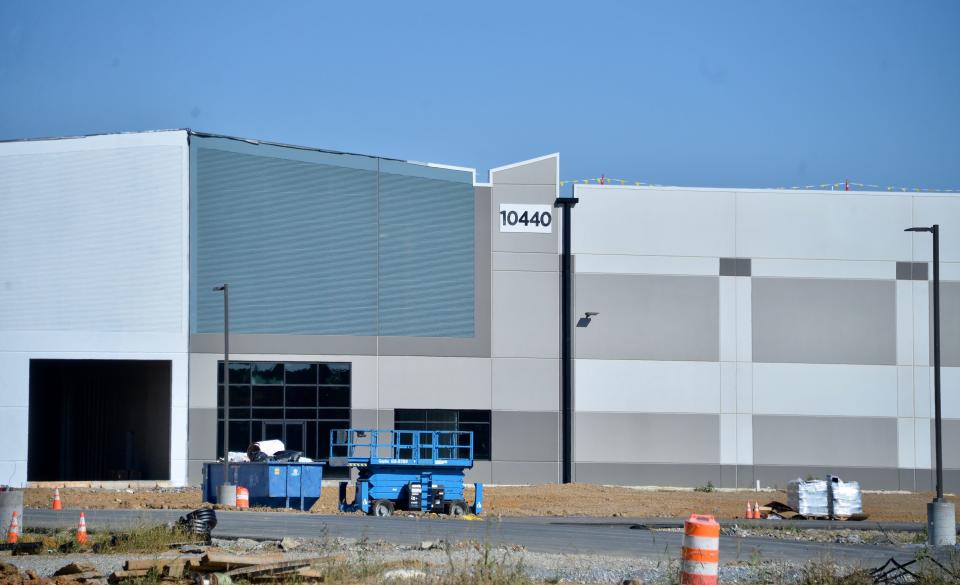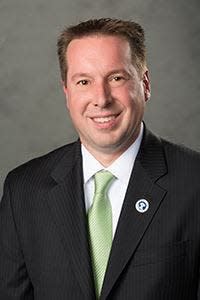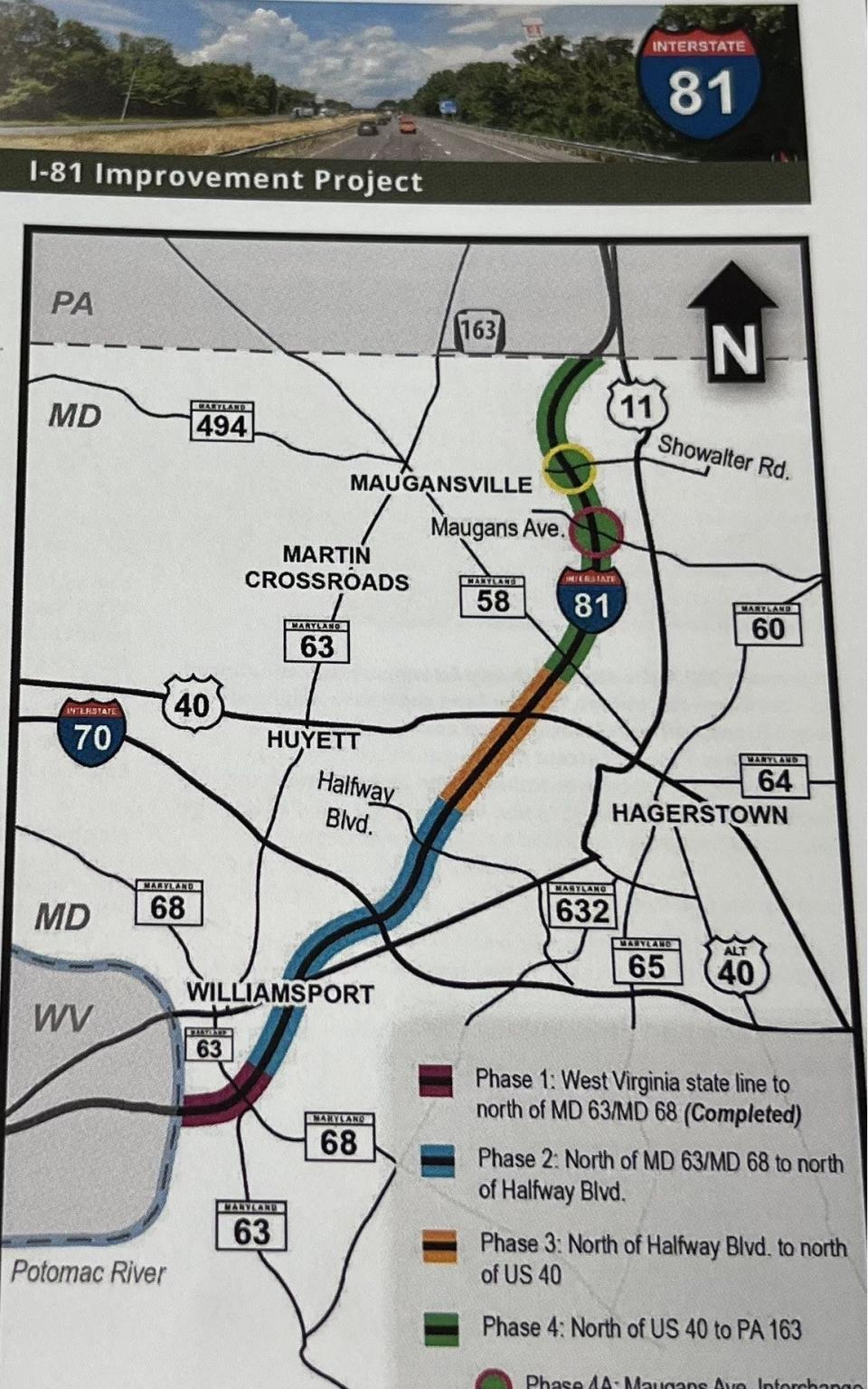A development boom can bring challenges, too. How will Washington County meet them?
Editor's note: This is the sixth in a series of stories looking at the growth and development in Washington County over the past few years, answering the question "Why now?"
Speaking to the Washington County Chamber of Commerce in June, the county's Director of Business Development Jonathan Horowitz said projects underway in 2023 represent an investment of about $1.3 billion and would ultimately result in an estimated 7,000 new jobs.
These projects include everything from manufacturing to distribution to tourism, health care, research and development, and small businesses.
Just last week, state and local officials announced Conair would lease more than 2 million square feet at a warehouse already under construction on Downsville Pike, bringing 700 full-time jobs over 10 years.
In many ways, the development and revitalization occurring now in Washington County is long-awaited good news. But it's not without its challenges.
As developers and business leaders weigh the risks and advantages of new projects, local governments grapple with questions that don't always have simple answers.
What kind of development is appropriate? Can the roads handle added traffic? What about water capacity? Where will everyone live? Where will their children be educated? And what are we doing about social issues that have already been a challenge?
Is there such a thing as too much?
The construction of a number of large warehouses in portions of the county has prompted much discussion among county residents, and that's putting it mildly — especially when these mammoth buildings have been constructed on land that was previously considered rural.
"We understand that they're much more visible than all the other great things we've developed in this county," Horowitz told The Herald-Mail.
But county officials have frequently pointed out that these structures have been built in areas zoned for industrial and commercial use. As the last comprehensive land use plan was drafted 10 years ago, residents were begging for more economic development, Horowitz said, so the result was more highway-interchange zoning.
It took seven years for that growth to appear, however, and when it did, "we ended up developing what I would call 10 years of development in three years," he said. "And that's going to be tough for any community to sustain financially, infrastructure-wise or just really with our citizens."
Horowitz also told the Washington County Chamber of Commerce that nearly 300,000 acres, or 41%, of the county is still agricultural, however. His office has a staff member, Leslie Hart, who is dedicated to agriculture —which remains one of the county's major economic drivers.
Last week, the Washington County Commissioners approved the purchase of an easement to preserve another 40 acres of agricultural land in Fairplay. Rural Preservation Administrator Chris Boggs said that during the current fiscal year, "I expect to surpass 40,000 acres of permanently preserved land in Washington County."
But in the meantime, concerns about losing agricultural property persist despite the county's efforts to preserve it.

"I like to make it very clear that we don't let anybody do anything" on property zoned for development, Horowitz told The Herald-Mail. Local government has little control over private industry, he said. "We try to guide the private industry, but nobody wants the government telling them what they can or can't do.
"It's an easy finger to point at us," Horowitz said, "but we do our best to make impact where we have control. But the county government does not dictate private industry."
Horowitz's comments echoed those made to The Herald-Mail by Washington County Planning Director Jill Baker earlier this year.
"Many residents don't want warehouses," she said, "however, 20 years ago, that's exactly what we planned for. There's nothing new here; nobody said, 'Don't do it.' What is surprising is how quickly it came upon us. It was sort of like the housing boom in the early 2000s. It's not that nobody didn't expect houses to come, it's just how quick, how many."
But as reported earlier, Horowitz said that while it hasn't all been developed yet, most of the undeveloped property zoned for industrial or commercial use has been spoken for.
It was "the first to get taken. It's the easiest developed," he said. "People want new buildings … It's what I call the 'low-hanging fruit' … and that's what this community has seen being done mostly for the last three or four years."
But Horwitz said "that has hit a head, because there really is no available easily developed green space."
How do you provide services for all that growth?
In practical terms, the development now occurring in Washington County brings implications on almost every level. Ask state Sen. Paul Corderman whether we're preparing adequately for that, and the answer is an emphatic "No."

Water capacity, roads, sewer systems, schools and housing emerged as frequent topics of conversation among local officials, even before the latest surge. That isn't likely to change anytime soon.
And "that's not unique to Washington County," said Corderman, a Hagerstown Republican who represents Washington and Frederick counties. "It's everywhere.
"You have water lines that are failing. You have sewer lines and pumps that need to be replaced. You have the highways … we need to be looking at school construction and funding for construction. How are we gonna be able to say that we're investing in our infrastructure and preparing for these growth opportunities if we're not even having the foresight or the vision to continue to upgrade and expand our school systems?"
Municipalities from Hancock to Boonsboro started lobbying the state hard for help with their water treatment systems years ago. The development of Lanco-Pennland, the dairy cooperative with a plant near Hancock, made that town's needs more acute. Washington County Commissioner Wayne Keefer, who lives in Hancock, noted to The Herald-Mail this week that Lanco-Pennland is working with the town to help address those needs.
During the coming legislative session of the Maryland General Assembly, the Washington County Community Coalition lobbying partnership plans to press a request for a long-term study of water distribution in Hagerstown and throughout the county.
The study would examine water system needs over the next 30 years.
"This study would at least identify a starting point for where we need to go," Jim Kercheval, executive director of the Greater Hagerstown Committee, told the Hagerstown City Council this month.
Although money for the study was sought last year, none was granted.
Meanwhile, municipalities are looking for ways to improve their own systems. Hagerstown, for example, is exploring the possibility of building a new potable water plant along the Antietam Creek as an alternate source of water, but that is still in the evaluation stage.
And then there are the roads. More specifically, Interstate 81.

Construction money — $100 million — was been added to Maryland's Consolidated Transportation Plan last year for Phase 2 of the project to widen I-81; Kercheval said the next goal is another $10 million toward design of the final phase that would take the project to the Pennsylvania line.
Also in the works is a study from the State Highway Administration for relocating the U.S. 11 bridge across the Potomac River at Williamsport, which becomes congested any time I-81 is shut down.
Where will people live?
Rob Ferree, president of Bowman Development, looks up and down I-81 and sees major development not only in Washington County, but in Berkeley County, W.Va., and Franklin County, Pa., too. All of that creates a demand for labor, he said, and the workers need places to live.
Horowitz sees the same issue, as does Kercheval.
"Right now we have a lot of concern, in the housing prices," Kercheval said. "We were tracking historically the median household income in the county, and what that level of income, what amount of home they can afford" based on a formula that assumes 30% of income goes to paying off debt on a home.
"Historically, for the county, the majority of the years over the last 20 or 25 years have shown that our median household income can afford a house that happens to be about the same as our median sales price. So if you could afford a $200,000 home, at that time, the median sales price in our county is $200,000.
"But just the last couple years, we've seen that gap go from about even in 2020-2021, to about a $140,000 gap. So our median sales price is in the upper $300,000s, nearly $400,000, where still with our household income, we can only afford a $250,000, to $260,000 home"
The median list price of a home in Washington County was $384,925 in August, according to an analysis by Realtor.com — an increase of nearly 20% from the year before. Fewer homes were listed this year, too — about 150 newly listed in August compared to 180 new August listings the year before.
"When you see that number, you need to be concerned," Kercheval said. "We need to look at a multi-faceted approach into how we provide housing for the workforce level here, because if you don't, if you can't afford the people that you need to fill the jobs, that creates a whole challenge within your economic ecosystem."
That includes "looking at density differently in our urban areas; in the areas designed for residential development," he said.
"Density is not a bad word, if it's connected with quality development. So trying to see that our developments are built to create nice neighborhoods where you have access to open space, access to maybe even some mixed-use commercial development to limit your amount of driving you have to do all the time, where you can kind of live, work and play all within a short distance. Those are things that we need to look at, if we're going to get the price of housing down."
Can redevelopment thrive in spite of social challenges?
Opioid addiction and associated crimes and homelessness have been a plague on the nation, and Washington County is no exception. The problems have been long documented, even as efforts are being made on many fronts to combat them.
The business community participates in those efforts, says Washington County Chamber of Commerce President Paul Frey.
"We're working with the (Hagerstown) mayor and council, we're working with (Hagerstown Community and Economic Development Director) Jill Thompson and her team, we're working with Goodwill, we're working with the Community Action Council, we're working with REACH (Religious Efforts to Assist and Care for the Homeless) in a couple of ways," he said.

As part of the Community Coalition, "we're in Annapolis together advocating for 'how can we address this?'
"The city wants to look at some of the derelict housing, how can we address that? So we're working with them. We are working on how can we address those issues," he said.
From the Chamber's perspective, "if we can have a thriving economic community, we can have more jobs, we can have higher-paying jobs … we can provide more opportunities and frankly, provide more base tax money for the city and the county and the state to help address some of these human service needs," he said.
"We understand we don't own these problems," he added. "I don't think the problems are being ignored. I think they're complicated. They're complex. They go hand-in-hand — thriving private sector, you also have to have a good quality of life, so you can have social programs, you have to have arts and entertainment, restaurants, you have to have public safety, good education at the K through 12 and above. So we're partnering, and I think all these folks are working together for a common solution."
Education is one area where such cooperation already is paying dividends. While the business community is involved in a number of activities such as apprenticeships and sponsorships, focus on preschool education brought eye-opening results.
School officials and the Greater Hagerstown Committee recognized many local students were starting school at a disadvantage, and began to focus on improving pre-K services so that more children would start kindergarten ready to learn.
And there was plenty of room for improvement. Washington County Public Schools ranked 23rd among Maryland's 25 public school systems for kindergarten readiness in 2016, according to numbers reported last spring by Associate Superintendent for Curriculum and Instruction Gary Willow.
Only 33% of those kindergarteners enrolled ready to learn.
By 2022, however, WCPS saw a 20% improvement in those numbers and had risen to the fourth highest percentage in the state — a feat Willow credited to an investment in pre-kindergarten programming. WCPS offers free universal pre-K programs.
Greater Hagerstown explored a learning program called "On-Track" to address learning from "cradle to career." The school system, meanwhile, made major investments in early education, even before early education was enshrined in the state's Blueprint for Maryland's Future education policy.
"I still believe there's a need for that type of collaboration all across those age levels, but you can almost check a lot of those boxes off in early childhood," Kercheval said.
"We still have to get more kids interested in mathematics and science," he added, "particularly if we're going to try to attract the trades up here that pay higher wages."
Washington County is in a transition period, with both benefits and challenges. How both are handled will determine how the growth surge will affect the county's future.
Next week: What will Washington County look like in a few years?
Have you noticed all the new development in Washington County? There's a reason for it
Starting at the core: How one big venture reflected a sea change for downtown Hagerstown
Hagerstown's new factory, med school and stadium: Why are these projects 'game-changers'?
These Washington County developers are putting old buildings back to work.
Port 44 and Ritchie Revival: Can targeted determination help rejuvenate communities?
This article originally appeared on The Herald-Mail: How will Washington County meet the challenges development brings?

